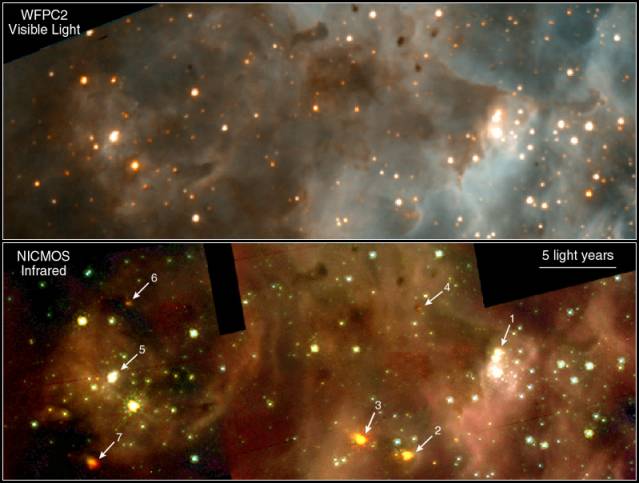
|
Credit & Copyright: John Trauger (JPL),
James Westphal (Caltech),
Nolan Walborn (STScI),
Rodolfo Barba' (La Plata Observatory),
NASA
Explanation:
Compare these
matched Hubble Space Telescope views
(visible-light on top; infrared on bottom) of a region
in the star-forming
30 Doradus Nebula.
Find the numbered
arrows in the infrared image which
identify newborn massive stars.
For example,
arrows 1 and 5 both point to compact clusters of
bright young stars.
Formed within
collapsing gas and dust clouds, the winds and radiation
from these hot stars have cleared away the remaining obscuring material
making the clusters easily apparent in both visible and infrared images.
But still shrouded in dust and readily seen only in the penetrating infrared
view are
newborn stars and star systems
indicated by arrows 2, 3, and 4.
Perhaps even more remarkable are the infrared bright spots indicated
by arrows 6 and 7.
Exactly in a line on opposite sides of the bright cluster at arrow 5,
they may actually be caused by
symmetric jets of material produced
by one of the young cluster stars.
These luminous spots are each about 5 light-years from the
cluster and would
correspond to points at which the
energetic jet material impacts
the surrounding dust clouds.
|
January February March April May June July August September October November December |
| ||||||||||||||||||||||||||||||||||||||||||||||||
NASA Web Site Statements, Warnings, and Disclaimers
NASA Official: Jay Norris. Specific rights apply.
A service of: LHEA at NASA / GSFC
& Michigan Tech. U.
Based on Astronomy Picture
Of the Day
Publications with keywords: LMC - star formation - massive stars - 30 Doradus
Publications with words: LMC - star formation - massive stars - 30 Doradus
See also:
- APOD: 2025 December 9 Á The Heart of the Soul Nebula
- APOD: 2025 July 10 Á Lynds Dark Nebula 1251
- APOD: 2025 June 23 Á W5: Pillars of Star Formation
- APOD: 2025 April 28 Á Gum 37 and the Southern Tadpoles
- APOD: 2025 March 26 Á Star Formation in the Pacman Nebula
- APOD: 2024 October 22 Á M16: Pillars of Star Creation
- Star Factory Messier 17
